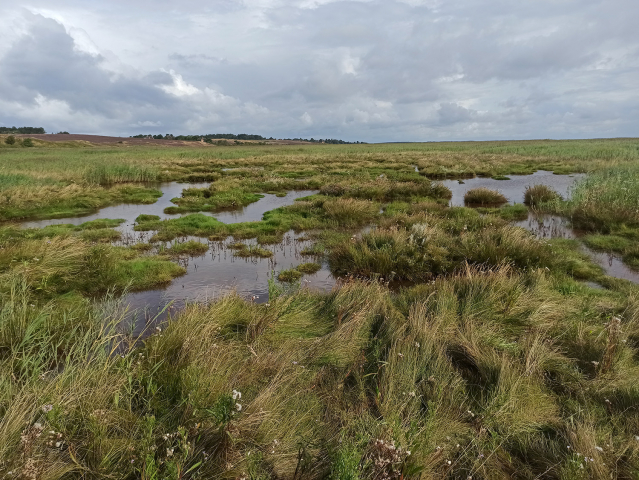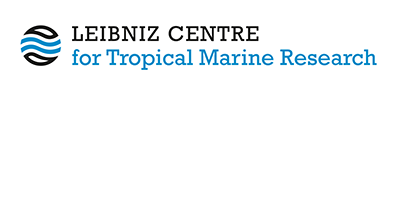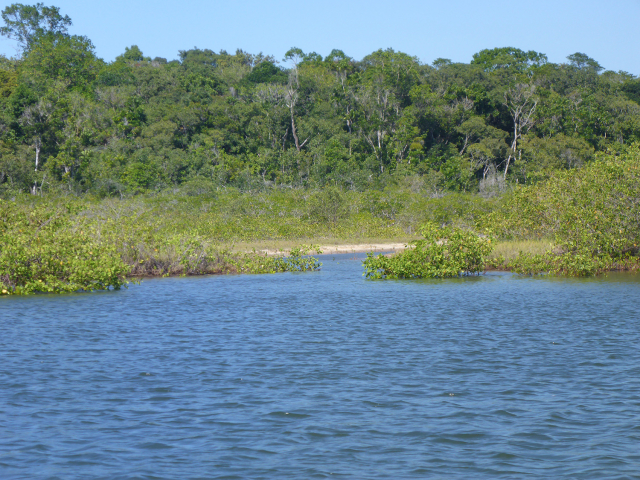20/08/2021 | Developing innovative and socially accepted approaches to improve the natural potential for carbon storage in vegetation-rich coastal ecosystems: that is the goal of the new research consortium sea4soCiety, coordinated by the Leibniz Centre for Tropical Marine Research (ZMT) in Bremen. Germany’s Federal Ministry of Education and Research (BMBF) is funding the consortium with 5.3 million euros as part of the first research mission “Marine carbon sinks in decarbonization pathways” – in short: CDRmare – of the German Marine Research Alliance (DAM).
As one of a total of six research consortia in the mission "Marine carbon sinks in decarbonization pathways", sea4soCiety will bring together almost 40 scientists from nine northern German universities and research institutes. Over the course of the three-year funding phase they will quantify and analyse the storage capacity for "blue carbon" in four different types of coastal ecosystems on the German North Sea and Baltic Sea coasts, in the Caribbean and the Indonesian Sea. Martin Zimmer, Head of the Department of Ecology at ZMT and Professor of Mangrove Ecology at the University of Bremen, is responsible for coordinating the research project.
Vegetation-rich coastal ecosystems of tropical and temperate latitudes, such as mangrove forests, seagrass beds, salt marshes or kelp forests, absorb huge amounts of carbon dioxide (CO2) from the atmosphere. Mangrove forests in tropical regions alone absorb 40 to 60 million tonnes of carbon annually. That is about as much as road traffic in Germany emits as greenhouse gases per year. The salt marshes of the Wadden Sea on the German North Sea coast store about 20,000 tonnes of carbon annually. The storage of this so-called "blue carbon" is one of the most important services provided by coastal ecosystems.
In recent decades, urbanisation, erosion or pollution have increasingly damaged the properties, processes and services of many ecosystems in coastal regions worldwide. Consequently, the global capacity to compensate for CO2 emissions by storing "blue carbon" in coastal ecosystems has also declined.
“We need concrete measures to counteract this trend so that coastal ecosystems can continue to contribute to climate change mitigation,” explains coordinator Martin Zimmer. “If these ecosystems can absorb more carbon dioxide, this will not only help mitigate the effects of climate change such as sea level rise and extreme weather events, but will also benefit biodiversity and productivity in coastal regions, which in turn can contribute to societal well-being and economic stability.”

Salt marsh in Braderup on the German island of Sylt | Photo: Ketil Koop-Jakobsen, AWI
The researchers will contribute scientific expertise in coastal ecology, chemistry, sedimentology, geology, hydrodynamics, remote sensing and modelling to quantify the storage capacity of "blue carbon" in seagrass beds, algae, salt marshes and mangrove forests and compare it with the depots of organic material in unvegetated marine sediments.
The origin, stability and dynamics of organic matter are analysed in the field and in the laboratories of the collaborative partners. Satellite data and ship-based measurements are used to determine the biomass on land and underwater in coastal zones. Communication with local societies, modelling and scenarios will make an evaluation of the potential benefits and risks of increasing the area of coastal ecosystems beyond their current stocks possible.
“By characterising habitat conditions of coastal vegetated ecosystems, we can identify unvegetated coastal stretches that would be suitable for either expanding or creating new coastal ecosystems,” says Zimmer. “Ecosystem design, i.e. the targeted implementation of ecosystems for the restoration of ecosystem services, plays a central role in our approach to formulating recommendations for the future management of coastal ecosystems.”
Socio-ecological component of the joint project
According to the researchers, suitable measures should be ecologically feasible, environmentally compatible and legally and ethically unobjectionable. Natural scientists are working closely together with researchers from the fields of human geography, socio-economics, ethics and law in an interdisciplinary network to ensure that the approaches to improving carbon storage in coastal ecosystems meet societal requirements, create additional benefits and are based on broad acceptance.
Based on the results of socio-ecological studies, both a roadmap for the sustainable use of marine carbon reservoirs and evidence- and scenario-based recommendations for politics, the private sector and society will be developed. Based on local field research, these proposals will be extrapolated up to scales of national, international and global relevance.
“Thus, in an innovative and participatory approach, new governance pathways will be designed that take into account local needs for ecosystem services in addition to mitigating climate change by sequestering ‘blue carbon’," explains geographer Beate Ratter from the Center for Earth System Research and Sustainability (CEN) at the University of Hamburg.
“With its socio-ecological orientation, the project is embedded within the DAM research mission 'Marine carbon sinks in decarbonization pathways' in a multidisciplinary network to investigate natural science, technological, societal, legal and ethical aspects of different CO2 removal methods. Thus, sea4soCiety makes a further and very specific contribution to the overall goal of the mission,” says Gregor Rehder from the Leibniz Institute for Baltic Sea Research Warnemünde (IOW) and one of the spokespersons of the research mission.
“By increasing the capacity of coastal ecosystems to sequester greenhouse gases and securing additional ecosystem services, the sea4soCiety research network contributes to achieving the goals of the Paris Climate Agreement, the United Nations Framework Convention on Climate Change (UNFCCC) and the United Nations 2030 Agenda,” Martin Zimmer concludes.
Members of the sea4soCiety consortium:
Professor Dr Martin Zimmer (coordinator), Leibniz Centre for Tropical Marine Research (ZMT), Bremen
Professor Dr Kai Bischof, Faculty 2 Biology/Chemistry, University of Bremen
Dr Annette Breckwoldt, Leibniz Centre for Tropical Marine Research (ZMT), Bremen
Professor Dr Thorsten Dittmar, Institute for Chemistry and Biology of the Marine Environment (ICBM), Carl von Ossietzky University of Oldenburg
Dr Mar Fernandez-Mendez, Alfred Wegener Institute Helmholtz Centre for Polar and Marine Research, Bremerhaven
Professor Dr Jan-Hendrik Hehemann, MARUM – Center for Marine Environmental Sciences at the University of Bremen
Professor Dr Kai Jensen, Center for Earth System Research and Sustainability (CEN), University of Hamburg
Dr David Keller, GEOMAR Helmholtz Centre for Ocean Research Kiel
Dr Ketil Koops-Jakobsen, Alfred Wegener Institute Helmholtz Centre for Polar and Marine Research, Sylt
Dr Manuel Liebeke, Max Planck Institute for Marine Microbiology, Bremen
Professor Dr Nele Matz-Lück, Kiel Marine Science, Kiel University (CAU)
Dr Peter Müller, University of Hamburg
Professor Dr Natascha Oppelt, Kiel Marine Science, Kiel University (CAU)
Dr Maike Paul, Leibniz University Hanover
Professor Dr Beate Ratter, Center for Earth System Research and Sustainability (CEN), University of Hamburg
Professor Dr Katrin Rehdanz, Kiel Marine Science, Kiel University (CAU)
Dr. Jens Schneider von Deimling, Kiel Marine Science, Kiel University (CAU)
Dr Joscha Schmiedt, Leibniz Centre for Tropical Marine Research (ZMT), Bremen
Dr Michael Seidel, Institute for Chemistry and Biology of the Marine Environment (ICBM), Carl von Ossietzky University of Oldenburg
Professor Dr Klaus Wallmann, GEOMAR Helmholtz Centre for Ocean Research Kiel
About the research mission:
In the research mission “Marine carbon sinks in decarbonization pathways” – in short: CDRmare – of the German Marine Research Alliance (DAM), about 200 scientists in six collaborative research consortia are investigating, how and to what extent the ocean can play a sustainable role in the removal and storage of carbon dioxide from the atmosphere. The long-term goal is to develop a roadmap for the active use of marine carbon sinks in order to contribute to the mitigation of the impacts of anthropogenic climate change and to help achieve the Paris climate goals. CDRmare (CDR = Carbon Dioxide Removal) is coordinated at the GEOMAR Helmholtz Centre for Ocean Research Kiel and the Leibniz Institute for Baltic Sea Research Warnemünde. Germany's Federal Ministry of Education and Research is funding the research mission with 27 million euros over an initial phase of three years (1.8.2021 - 31.7.2024). Further information: www.cdrmare.de/en
The German Marine Research Alliance and its 22 member institutions develop solutions-oriented knowledge and potential courses of action for the sustainable use of coasts, seas and oceans
About the Leibniz Centre for Tropical Marine Research (ZMT)
In research and education, the Leibniz Centre for Tropical Marine Research (ZMT) in Bremen is dedicated to the better understanding of tropical coastal ecosystems such as mangroves, sea grasses, coral reefs, estuaries and upwelling systems. As an interdisciplinary Leibniz institute, the ZMT conducts research on the structure and functioning of tropical coastal ecosystems and their reaction to natural changes and human interactions. It aims to provide a scientific basis for the protection and sustainable use of these ecosystems. ZMT works in close cooperation with partners in the tropics, where it supports capacity building and the development of infrastructures in the area of sustainable coastal zone management. ZMT is a member of the Leibniz Association. More information at www.leibniz-zmt.de
Die Forschenden werden naturwissenschaftliche Expertise in Küstenökologie, Chemie, Geologie, Hydrodynamik, Fernerkundung und Modellierung einbringen, um die Speicherkapazität für "blauen Kohlenstoff" in Seegraswiesen, Algenbeständen, Salzmarschen und Mangroven zu quantifizieren und mit den Depots organischen Materials in unbewachsenen marinen Sedimenten zu vergleichen.
Herkunft, Stabilität und Dynamik der Speicher organischen Materials werden vor Ort und in den Laboren der Verbundpartner analysiert. Satellitendaten und Schiffsmessungen dienen dazu, die Biomasse an Land und unter Wasser in den Küstenzonen zu ermitteln. Kommunikation mit der lokalen Bevölkerung, Modelle und Szenarien ermöglichen eine Evaluierung der möglichen Nutzen und Risiken, die eine Flächenvergrößerung der Küstenökosysteme über ihre derzeitigen Bestände hinaus mit sich bringen könnte.
„Indem wir den jeweiligen Lebensraum charakterisieren, können wir zugleich unbewachsene Küstenregionen identifizieren, die sich eignen würden, um dort benachbarte Küstenökosysteme entweder auszudehnen oder neu anzulegen“, so Zimmer. „Ökosystem-Design, also die Gestaltung von Ökosystemen zur gezielten Wiederherstellung von Ökosystemleistungen, spielt eine zentrale Rolle in unserem Ansatz zur Formulierung von Handlungsempfehlungen für die Zukunft der Küstenökosysteme.“
Sozio-ökologische Komponente des Verbundvorhabens
Geeignete Maßnahmen sollen ökologisch umsetzbar, umweltverträglich sowie rechtlich und ethisch unbedenklich gestaltet sein, so der Anspruch der Forschenden. Damit die Ansätze zur Verbesserung der Kohlenstoffspeicherung in Küstenökosystemen gesellschaftlichen Anforderungen entsprechen, zusätzlichen Nutzen schaffen und auf breiter Akzeptanz beruhen, arbeiten Naturwissenschaftler:innen mit Forschenden aus den Bereichen Humangeografie, Sozioökonomie, Ethik und Rechtswissenschaften im Verbund interdisziplinär eng zusammen.
Auf Basis der Ergebnisse sozio-ökologischer Studien sollen eine Roadmap für die nachhaltige Nutzung mariner Kohlenstoffspeicher erstellt sowie evidenz- und szenarienbasierte Empfehlungen für Politik, Wirtschaft und Gesellschaft entwickelt werden. Ausgehend von der lokalen Feldforschung werden diese Vorschläge auf Ebenen von nationaler, internationaler und globaler Relevanz hochskaliert.
„So werden in einem innovativen und partizipativen Ansatz neue Governance-Wege gestaltet, die zusätzlich zur Eindämmung des Klimawandels durch die Bindung von "blauem Kohlenstoff" lokale Bedürfnisse nach Ökosystemleistungen berücksichtigen“, erklärt die Geografin Beate Ratter vom Centrum für Erdsystemforschung und Nachhaltigkeit (CEN) der Universität Hamburg.
„Mit seiner sozio-ökologischen Ausrichtung ist das Projekt im Rahmen der DAM-Forschungsmission ‘Marine Kohlenstoffspeicher als Weg zur Dekarbonisierung‘
in ein multidisziplinäres Netzwerk zur Untersuchung naturwissenschaftlicher, technologischer, gesellschaftlicher, rechtlicher und ethischer Aspekte verschiedener CO2-Entnahmemethoden eingebettet. Somit leistet sea4soCiety einen weiteren und sehr spezifischen Beitrag zum Gesamtziel der Mission“, sagt Gregor Rehder vom Leibniz-Institut für Ostseeforschung Warnemünde (IOW) und einer der Sprecher der Forschungsmission.
„Indem wir die Kapazität der Küstenökosysteme zur Bindung von Treibhausgasen erhöhen und zusätzliche Ökosystemleistungen sichern, trägt der Forschungsverbund sea4soCiety dazu bei, die Ziele des Pariser Klimaabkommens, der Klimarahmenkonvention der Vereinten Nationen (UNFCCC) und der Agenda 2030 der Vereinten Nationen zu erreichen“, fasst Martin Zimmer zusammen.
Antragstellende Mitglieder im Verbund sea4soCiety:
Prof. Dr. Martin Zimmer (Koordinator), Leibniz-Zentrum für Marine Tropenforschung (ZMT), Bremen
Prof. Dr. Kai Bischof, Fachbereich 2 Biologie/Chemie, Universität Bremen
Dr. Annette Breckwoldt, Leibniz-Zentrum für Marine Tropenforschung (ZMT), Bremen
Prof. Dr. Thorsten Dittmar, Institut für Chemie und Biologie des Meeres (ICBM), Carl von Ossietzky Universität Oldenburg
Dr. Mar Fernandez-Mendez, Alfred-Wegener-Institut Helmholtz-Zentrum für Polar- und Meeresforschung, Bremerhaven
Prof. Dr. Jan-Hendrik Hehemann, MARUM - Zentrum für Marine Umweltwissenschaften an der Universität Bremen
Prof. Dr. Kai Jensen, Centrum für Erdsystemforschung und Nachhaltigkeit (CEN), Universität Hamburg
Dr. David Keller, GEOMAR Helmholtz-Zentrum für Ozeanforschung Kiel
Dr. Ketil Koops-Jakobsen, Alfred-Wegener-Institut Helmholtz-Zentrum für Polar- und Meeresforschung, Sylt
Dr. Manuel Liebeke, Max-Planck-Institut für Marine Mikrobiologie, Bremen
Prof. Dr. Nele Matz-Lück, Kiel Marine Science, Christian-Albrechts-Universität zu Kiel
Dr. Peter Müller, Universität Hamburg
Prof. Dr. Natascha Oppelt, Kiel Marine Science, Christian-Albrechts-Universität zu Kiel
Dr. Maike Paul, Leibniz Universität Hannover
Prof. Dr. Beate Ratter, Centrum für Erdsystemforschung und Nachhaltigkeit (CEN), Universität Hamburg
Prof. Dr. Katrin Rehdanz, Kiel Marine Science, Christian-Albrechts-Universität zu Kiel
Dr. Jens Schneider von Deimling, Kiel Marine Science, Christian-Albrechts-Universität zu Kiel
Dr. Joscha Schmiedt, Leibniz-Zentrum für Marine Tropenforschung (ZMT), Bremen
Dr. Michael Seidel, Institut für Chemie und Biologie des Meeres (ICBM), Carl von Ossietzky Universität Oldenburg
Prof. Dr. Klaus Wallmann, GEOMAR Helmholtz-Zentrum für Ozeanforschung Kiel
Über die Forschungsmission
In der Forschungsmission „Marine Kohlenstoffspeicher als Weg zur Dekarbonisierung“ – kurz: CDRmare – der Deutschen Allianz Meeresforschung (DAM) untersuchen rund 200 Forschende in sechs Verbundprojekten, wie und in welchem Umfang der Ozean eine nachhaltige Rolle bei der Entnahme und der Speicherung von Kohlendioxid aus der Atmosphäre spielen kann. Langfristiges Ziel ist die Entwicklung einer Roadmap für die aktive Nutzung mariner Kohlenstoffspeicher, die dazu beitragen soll, die Folgen des menschengemachten Klimawandels zu begrenzen und die Pariser Klimaziele zu erreichen. Übergreifend koordiniert wird CDRmare (CDR = Carbon Dioxide Removal = Kohlendioxidentnahme) am GEOMAR Helmholtz-Zentrum für Ozeanforschung Kiel und am Leibniz-Institut für Ostseeforschung Warnemünde. Das Bundesministerium für Bildung und Forschung (BMBF) fördert die Forschungsmission mit 27 Mio. Euro über eine erste Phase von drei Jahren (1.8.2021 – 31.7.2024). Weitere Informationen: www.cdrmare.de
Die Deutsche Allianz Meeresforschung erarbeitet mit ihren 22 Mitgliedseinrichtungen lösungsorientiertes Wissen und Handlungsoptionen für einen nachhaltigen Umgang mit den Küsten, Meeren und Ozeanen.





